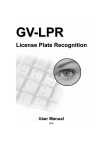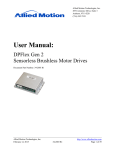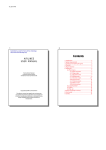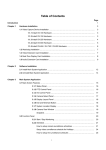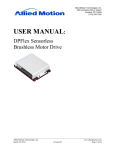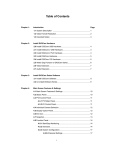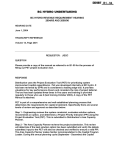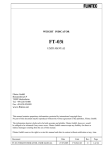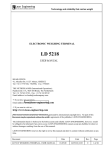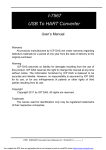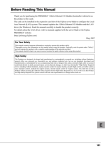Download GV-LPR License Plate Recognition User Manual
Transcript
GV-LPR License Plate Recognition User Manual V2.1.3 Table of Contents Page Chapter 1 Chapter 2 Hardware Installation 1 1.1 Installation of Video Capture Card 1 1.2 Installation of Key-pro 2 1.3 Installation of the I/O Module 3 1.3.1 Install GV-NET Card 4 1.3.2 Install GV-NET 5 1.3.3 Install GV-I/O 6 1.3.4 Install GV-RELAY 7 Software Installation 9 2.1 Install GV-LPR Application 9 2.2 Install Microsoft Data Access Components (MDAC) Chapter 3 2.2.1 Check the version of MDAC 12 2.2.2 Install MDAC 14 2.3 Run GV-LPR Application 16 2.4 Uninstall GV-LPR Application 16 System Configuration 17 3.1 Main Screen Features 17 3.2 System Configure 20 3.2.1 System Configuration Chapter 4 12 20 3.2.1.1 General Setting 20 3.2.1.2 Camera 1 ~ 8 24 3.2.1.3 I/O Device 30 3.2.2 Recognition Setup 35 3.2.3 Integration 38 3.2.4 Export Setup 39 3.2.5 Counter Setting 43 3.2.6 Repeat Recognition Setting 44 3.2.7 Country Setting 44 3.2.8 Video Source 44 3.3 Start/Stop Recognition 45 3.4 Exit/Minimize 45 4.1 Recognition Records 47 4.2 Recognition Database 48 4.2.1 Query 48 i Chapter 5 Chapter 6 4.2.2 Open Recognition Database 49 4.2.3 Delete Recognition Records 49 4.2.4 Export Recognition Records 49 4.2.5 Image Adjustment 50 4.2.6 View Recognition Video (to be used with DVR integration) 50 4.2.7 View Related Video (to be used with DVR integration) 51 4.3 Watermark Proof 51 Registered Plates Database 53 5.1 Add Record 54 5.2 Edit Record 54 5.3 Delete Record 54 5.4 Find Record 55 5.5 Filter Records 55 5.6 Go to Record 55 5.7 Print 56 5.8 Print Preview 56 Notifications 57 6.1 I/O Notifications 57 6.2 Hotkey View 58 ii Chapter 1 Hardware Installation 1 CHAPTER Hardware Installation The Hardware components included in your system may vary depending on the model or optional features you purchased. This chapter will describe all available hardware components of the GV-LPR system and its installation procedures. 1.1 Installation of Video Capture Card 1. Power-off the PC. 2. Insert PCI card into PCI slots. 3. Connect the Hardware Watchdog line. 4. Connect the video camera signal lines. 5. Turn on PC power. Windows will automatically detect the existing cards. Ignore the wizard window and keep on the following step. 6. Select the driver path in the CD directory \Driver, run DrvInst.exe to install the driver. Video Extension Port Real Time Display Card Connector Video Input Audio Input Connector Watchdog Jumper GeoVision GV-600v2 GV-600 v2 1 Chapter 1 Hardware Installation Real Time Display Card Connector Audio Input Connector Video Extension Port Video Input Watchdog Jumper GV-650/GV-750/GV-800 Video Capture Card Connection of Hardware Watchdog 1.2 Installation of Key-pro The Key-pro is a 4.7 cm x 2 cm x 0.9 cm blue color USB plug-in key. It can be used for the USB port that supports USB 1.1 or above. Please plug in the Key-pro in the USB port before lunching the GV-LPR system. The Key-pro for 1, 2, 4, 6 and 8 lanes are different. Without the Key-pro the system cannot be run. 2 Chapter 1 Hardware Installation 1.3 Installation of the I/O Module GV-LPR supports I/O detection mode so that sensors can trigger the GV-LPR to do recognition. This section describes the installation of the I/O modules. 3 Chapter 1 Hardware Installation 1.3.1 Install GV-NET Card The GV-NET Card is an interface converter, which converts RS-232 to RS485. It should be installed inside a PC. Specifications RS-232 to PC RJ-11 to DB9 female cable RS-485 + Connect to GV-IO RS-485+ RS-485 - Connect to GV-IO RS-485 - Communication RS-485, 1,200~19,200 bps DC IN DC 5V, 1A Operation Environmental temperature 0~50 degree C Conditions Humidity 5%~95% (non-condensing) Compatible Models GV-NET Card: all models Dimensions 88mm x 99mm 4 Chapter 1 Hardware Installation 1.3.2 Install GV-COM GV-COM is a device that converts USB to RS-485 or RS-232. It is to be connected to the USB of your computer. Specifications Serial Interface Signal: DCD, RxD, TxD, DTR, GND, DSR, RTS, CTS RS-232 Connecter: DB9 Male Signal: D+, D RS-485 Connector: Terminal Block 16 KV ESD for All Signals Serial Line Protection USB 1.1, 1.0 Compliance USB USB 2.0 Backward Compatible Speed Full speed 12 Mbps Parity None, Even, Odd Data Bit 7, 8 Stop Bit 1 (default), 2 Flow Control RTS/CTS, XON/XOFF Speed 600 bps to 115,200 bps Environmental Operation 0°C~55°C Conditions Temperature Communication Parameters Humidity Dimensions 5%~95% (Non-Condensing) 103 (W) x 32 (H) x 64 (D) mm 5 Chapter 1 Hardware Installation 1.3.3 Install GV-I/O The GV-IO is an 8 points digital input and 16 point digital output controller. The dry relay contacts provide an interface to your external devices such as sensors or detectors. You may use the Normal Open or Common Connection Point, connect to the GND and IN1~8 of GV-IO respectively. Despite the connection of the lines, you should also setup in the I/O Setup of the GV-LPR software. Specification INPUT Input 8 Input Signal 0-5 V DC (floating) High State 5V Low State 0V Wiring Label GND, DI 1~DI 8 Output 16 Output Circuit TTL Open Collect OUTPUT +5V-1, DO 1-1 ~ DO 8-1 Wiring Label +5V-2, DO1-2 ~ DO 8-2 Communication RS485, 9600 bps RS-485+ Connect to GV-NET RS-485+ RS-485- Connect to GV-NET RS-485- DC IN Power Adapter DC 5V, 2A Inner Positive Environmental Operation temperature 0~50 degree C Humidity 5%~95% (non-condensing) Condition Dimension 202(W) x 166(H) x 39(D) mm 6 Chapter 1 Hardware Installation 1.3.4 Install GV-RELAY The GV-RELAY is a relay output module with 8 points relay output interface. This device is to actually control the gate, light or alarm and connects to the control source of GV-IO output. Despite the connection of the lines, you should also setup in the I/O Setup of the GV-LPR software. Specification Relay Output RL1~RL8 Relay Control Source +5V, DO1~DO8 connect Output of GV-IO Relay Status Normal Open Relay Capacitance P6A / 250V AC; 10A / 125V AC; 5A / 28V DC Relay ON Time 8ms Relay Off Time 5ms Dimension 202(W) x 166(H) x 39(D) mm 7 Chapter 1 Hardware Installation Please refer to the diagram below for the connection of the GV-NET, GV-IO and GV-RELAY. The GV-NET can be replaced by the GV-NET Card. Connection of GV-IO and GV-RELAY 8 Chapter 2 Software Installation 2 CHAPTER Software Installation All GV-LPR software applications and the drivers for the GV-Series capture cards are included in the CD provided within the system package. Please also refer to the images and videos within the CD as a reference for your installation. 2.1 Install GV-LPR Application Before starting the installation of GV-LPR, you should check if all the hardware components were installed properly. It is important that you complete the hardware installation in Chapter one first before proceeds to the software installation procedures below. 1. Insert GV-LPR CD into the CD-ROM drive of your PC. Please change to the folder of “Setup” and run “Setup.exe”. 9 Chapter 2 Software Installation 2. Click [Browse] if you wish to specify another destination directory otherwise click [Next] to proceed to the next step. 3. In the select program dialog box you may change the name for your GV-LPR folder in the empty text column under Program Folders. If you are not going to do any modification, simply click [Next] and the installation will start. Follow the rest of the instruction to complete the installation. 10 Chapter 2 Software Installation 4. Select whether you want to add it to the Startup so that the GV-LPR auto starts running when the PC is power on. It is suggested to select “yes”. 5. Finish the setup process. You may select to restart the computer immediately or later. It is recommended to restart the computer before running GV-LPR application. 11 Chapter 2 Software Installation 2.2 Install Microsoft Data Access Components (MDAC) Since GV-LPR uses Microsoft Data Access Components (MDAC) version 2.7 or above, please check if your system has install MDAC before running GV-LPR application. The MDAC checker and installer are included in “Utility” folder of the install CD. 2.2.1 Check the version of MDAC 1. Please select the folder of “Utility” and then “MdacChecker” from the install CD. 2. Run the “cc.exe”. 3. Please select “Perform analysis of your machine and automatically determine the release version” and press “OK”. 12 Chapter 2 Software Installation 4. The program will auto detect your MDAC version. 5. If the version is unknown, you may select “View” and then “File Detail” to view the version of MDAC. 13 Chapter 2 Software Installation 6. If the version is 2.7 or upper, you may skip the next section for install MDAC. Else, you should follow the instruction of next section to install MDAC. 2.2.2 Install MDAC 1. Please select the folder of “Utility” and then “Mdac2.8” from the install CD. 2. Run “mdac_typ.exe” 3. Please select “I accept all of the terms of the preceding license agreement” and press “Next”. 14 Chapter 2 Software Installation 4. Press “Finish” to start installation. 甲、 5. After complete of installation, please press “Close” to close the dialog and then restart Windows. 15 Chapter 2 Software Installation 2.3 Run GV-LPR Application 1. If you have added GV-LPR to the startup of Windows, it will be run after Windows starts up. Else, run the GV-LPR application from the GV-LPR folder. You may add a short cut at the desktop if needed. 2. Be sure you have plug in the USB Key-pro mentioned in Chapter 1, or else the system cannot be run. 3. The first time you run the GV-LPR application, the system will ask you to setup the password of Administrator. Please setup and DO NOT forget the password. 2.4 Uninstall GV-LPR Application 1. Select the Uninstall icon from the GV-LPR folder to uninstall GV-LPR software. 2. The uninstaller will prompt to confirm before uninstall. 3. The uninstaller will then remove all related files from your hard disk. 4. Images and database created by GV-LPR will not be removed. 16 Chapter 3 System Configuration 3 CHAPTER System Configuration GV-LPR application is a Windows based GUI system software that is used for control, setup, and monitor the GV-LPR System. The detail functions will be explained from Chapter 3 to Chapter 6. 3.1 Main Screen Features 17 Chapter 3 System Configuration 1. Camera Caption This caption shows the camera name and can be modified. Counter can also be shown here just after the Camera Caption if it is enabled. 2. Recognition Window PIP This is a Picture In Picture window, which is by default disabled. When enabled, by default this window shows the last recognized image. You may change it to show live video instead. Then the [Main Video Window] will be changed to show the recognized image. 3. Main Video Window This window default shows live video of the recognition camera. If [Recognition Window PIP] is enabled, it may be set to show live video or recognized image. 4. Overview Camera PIP This is a Picture In Picture window. It is default disabled. If an Overview Camera is setup for a lane, this window can be enabled to show the live video of the Overview Camera. An Overview Camera can be setup to capture the image of the driver or the overview of the car. 5. Recognition Status The status of the recognition will be shown here as Registered, Visitors or Unrecognized. 6. Manual Recognition Button This button is only been shown when [Manual Detect] recognition mode is selected. [Manual Detect] is normally been used when setting up the system, before the I/O device is ready. You may press the button to trigger the recognition. 7. Recognition Records This window shows the recent recognition records up to 5000 records. You may show the detail and image of the related record by double clicking on the record. 8. Recognition Image This window shows the last recognized image. 9. Recognition Result This window shows the date, time, camera name and the result of the last recognition. 18 Chapter 3 System Configuration 10. Registered image You may set the image of the drivers or the overview image of the vehicles as Registered Image. The image will be shown when the registered car is being recognized. The function can be used when the security is very concerned of. 11. Start/Stop Recognition You may select start or stop one or more lanes of recognition. 12. System Configure You may setup the system by System Configure. Please refer to the detail in the next section. 13. Notification I/O and Hotkey Notification. Please refer to Chapter 6. 14. Registered Plates Database It is used for the management of the Registered Plates Database. Please refer to Chapter 5 for the detail. 15. Version/ Exit/ Minimize You may show the version information, select to minimize or exit the GV-LPR application. 16. Recognition Database It is used for the management of the Recognition Database. Please refer to Chapter 4 for the detail. 17. View Window layout You may select to show 1, 4, 6, 8 or 9 windows to monitor the live video of the lanes. 18. Camera Selection You may select which lane or lanes to be shown in the [Recognition Records]. 19. View Window You may select the live video of a single lane so that you can see it clearly. 19 Chapter 3 System Configuration 3.2 System Configure When the first time GV-LPR is run, you will be prompted to select the country for your installation. This setting will define the recognition engine to be used. You may change the setting afterwards. Please read the detail of System Configure before start using the GV-LPR system. There are 8 setups in the System Configure. Press the [System Configure] shows the 8 selections. 3.2.1 System Configuration There are 3 kinds of setting: [General Setting], [Camera 1~8] and [I/O Device]: 3.2.1.1 General Setting 20 Chapter 3 System Configuration Camera Caption You may set the Camera Caption, whether turn off the display by selecting [OFF], shows the [Camera ID] or shows the [Camera ID + Name] at the upper left corner of the Main Video Windows. File Storage [Available] displays the available free space of your hard drive. If the first drive hits 2GB then the system will automatically switch to the second hard drive for recording when there is more than one hard drive have been assigned for the File Storage. If [Recycle Files] option is enabled then the system will start deleting the earliest image files to make space for the new image files when the system runs out of the free storage. If the [Recycle Files] option is not selected then the system will simply stop saving when there is no free storage. Click on the [Set Location…] button and the following [Location Setup] dialog will appear. This dialog box displays the location path of your saved image files and it’s available free space. You can click on the folder icon to [Add] or [Delete] location path for saving image files. Note: When integrated with DVR, please Do Not set the folder of video storage path of GV-Series DVR to the same logical hard drive of GV-LPR File Storage. That will cause the GV-Series DVR to use up the hard drive. 21 Chapter 3 System Configuration Image Duplication If you need to duplicate the image file to other disk for backup or system integration, you may enable [Image Duplication] and set [Image Duplication Filename Setup] and [Location]. Option It is advice to set the [Start Recognition At Startup] so that recognition starts when the application starts running. If [Display Recognition Region] is enabled, the recognized license plate region will be shown. If [Enable Directdraw Render] is enabled, better video quality can be provided by VGA card and its driver which supports Directdraw. Note: Please disable the “Enable Directdraw Render” when you are using dual screen mode when integrated with GV-Series DVR system because VGA does not support dual screen Directdraw. Alarm Sound Option For the Alarm warning, it can be set to be [play once] or [Repeat]. 22 Chapter 3 System Configuration Image Options The capture image for recognition is 720x480(NTSC) / 720x576(PAL). You may save the image with the size selected in the [Save Image Size]. [Digital Watermark] can be enabled so that the saved images could able to be proved that it has not been modified. The [Overlay Time] can write the time in the saved image file. You may set the font, whether to add [Stereo Frame] and adjust the [Text Alignment]. Password There are 3 level of privilege for Password: Administrator, Power User and User. Administrator has highest privilege with all access right. Power User and User cannot do any system configuration. User cannot add registered license plate into the system but Power User can do it. You may [Add], [Edit] or [Remove] the password. 23 Chapter 3 System Configuration 3.2.1.2 Camera 1 ~ 8 For 8 lanes product, the dialog will show settings for Camera 1 to Camera 8. For 1 or 2 lanes product, it will only Camera 1 or Camera 1 and Camera 2 settings etc. If you press this icon , the settings inside the rectangle region will be copied to all of the other cameras. General [Camera Name] You may set the Camera Name. [Video Source] You may select the Video Source from Capture Card or AVI file recorded by GV-Series DVR. You may repeat playing the AVI file if needed. The resolution of video source should be 720x240, 720x480, 720x576, 720x288 or 640x480 depends on the capture card installed from GV-Series. 24 Chapter 3 System Configuration You may set the [Video Attribute Setup] about for the Brightness, Contrast, Saturation and Hue. When GV-LPR is integrated with GV-Series DVR system, the [Video Attribute Setup] in GV-LPR will be disabled. You may set them in the GV-Series DVR system. Recognition [Detection Setup] [Detection Mode] There are [Manual Detection], [I/O Detection] and [Motion Detection] option. [Manual Detection] is mainly used while setting up the system, testing the recognition location before setting up the I/O device. You may press the [Manual Recognition button] (please refer to page 7) in the Main Video Window to trigger the recognition. [I/O Detection] is normally used for car park or entrance. [Motion Detection] is normally used on freeway recognition where I/O detection devices are not allowed to be installed. [Recognition Result From] There are 1 picture, 3 pictures and 5 pictures options to be selected. It is the number of images to be captured to be recognized for each trigger. It is used for [Manual Detection] and [I/O Detection] mode. The greater value provides more accuracy, and more CPU resource is needed. [Matching Mode] You may select the tolerance of comparison while performing matching the recognized result of the license plate with the registered database. There are 4 modes can be selected. There are All Characters Match, 1 Character Mismatch, 2 Characters Mismatch and 3 Characters Mismatch. [Setup Recognition Region] You may add or subtract the region where the license plate is to be recognized. License plates outside this region will not be recognized. To add or subtract the region, please drag your mouse in the [Recognition Region Setup] area and confirm with the left button on the mouse. 25 Chapter 3 System Configuration [Motion Detection] The settings in the area are only available when [Detection Mode] is selected to be [Motion Detection]. The maximum lanes supported for [Motion Detection] mode is 4 lanes. [Sensitivity] There are 9 levels of sensitivity can be selected. [Setup Motion Detection Region] You may add or subtract the motion sensor regions. To add or subtract the region, please drag your mouse in the [Motion Detection Region Setup] area and confirm with left button on the mouse. [Do not record for unrecognized result] This option is default enabled so that those recognition triggered by motion detection without license plate found can be eliminated. When [Motion Detection] mode is used, you should be very careful of the installation of the camera. Make sure that the size of license plate goes in and out of the camera view are nearly the same. Do not install so that it is a small license plate far away and becomes big when it comes nearer. Please refer to images below as the guideline. 26 Chapter 3 System Configuration [Options] You may set the [Drive Direction] to Incoming or Outgoing. Notification [Recognition Window PIP] You may enable the [Recognition Window PIP] so that the recognized image can be shown in the Picture In Picture form. By default this window shows the last recognized image. You may change it to show live video instead by changing the selection. Then the [Main Video Window] will be changed to show the recognized image. You may adjust the PIP window by enable the [Display Region] and then setup in the [Recognition Window PIP Display Region]. You may also reset it to default region by clicking the [Default Region] icon. [Overview Camera PIP] You may enable the [Overview Camera PIP] so that you can capture the image of the driver or the overview of the vehicle by installing another camera and shown in the Picture In Picture window. The image will be saved accompanied with the recognition image if you enable [Save Image as JPEG File]. You will see 2 images 27 Chapter 3 System Configuration when you are querying the Recognition Record Database. You may set the image file compression quality in the [Quality]. Higher quality images require more storage spaces. You may adjust the PIP window by enable the [Display Region] and then setup in the [Overview Camera PIP Display Region]. You may also reset it to default region by clicking the [Default Region] icon. [Notification] It is used to setup the notify output for the recognition. The selected options will be performed for Registered, Visitors or Unrecognized result. [Notify Message]: The input text will be shown on the Monitoring Window. [Display Time]: Set the time of showing the Notify Message. [Notify Sound]: Play the selected sound file if it is enabled. It is suggested that this is enabled for the Visitor and Unrecognizable so that the guards can be warned to take care of the event. [Save Image as JPEG File]: Option whether to save the image file. [Quality]: Higher quality images require more storage spaces. [Edit License Plate]: Option whether to show dialog to modify license plate. 28 Chapter 3 System Configuration [Video Attribute Setup] You may set the Brightness, Contrast, Saturation and Hue of the camera. 29 Chapter 3 System Configuration 3.2.1.3 I/O Device To use [I/O Detect] mode, you should set the [I/O Device]. Please refer to the video demonstration at the upper left corner of this dialog. It shows to 2 infrared sensors to trigger the recognition. 2 infrared sensors can prevent most of the trigger generated by people walk through. You can also adjust the distance of the 2 infrared to prevent bicycle or motorbike. Normally, it is at least 1.5 meter apart. Magnetic Loop Detector is the main sensor device to be used for I/O trigger. For Magnetic Loop Detector, 1 input is enough to trigger the system. [I/O Device] Before you can start using the I/O modules you have to setup the GV-LPR to recognize them first. You should have a GV-NET Card connected to the COM port of your computer or GV-COM module connected to the USB port of your computer. Please refer to Chapter 1. Select the device in the [Device] drop down menu, normally GV-IO, select COM port in [Port] and the module address from [Address], normally 1. Then click [Format Address] button. The [Add] button will be selectable if the system successfully found your module. Click the [Add] button and this module will appear in the list. You may remove or edit the device when you select the device and press [Remove] or [Edit] button. 30 Chapter 3 System Configuration After adding the I/O device, you may setup the [Pin Setup] of each pin to Normal Open or Normal Close by clicking the [NO/NC Setup] button. [Input Setup] You can select the I/O device to set. Input Setup 1~8 are mainly for triggering recognition. Input Setup 9~12 can be used for auxiliary purpose if needed. Input Setup 1 is for camera 1 and so on. There are maximum 4 inputs to trigger the recognition of a camera. If you are only going to set an input to trigger the recognition, you may just enable the input 1. If you are going to use two inputs to trigger the recognition, you should enable both input 1 and input 2, etc. When you set Input 1 and Input 2 it means that it will trigger recognition only when input 1 is triggered and then input 2 is also triggered before the trigger of input 1 is off. It will not trigger recognition when input 2 is triggered and then input 1 is also triggered. This can help when concerning with the drive direction. 31 Chapter 3 System Configuration [Sensor Name] You may set the name of the sensor in the [Sensor Name]. [Pin Setup] Be remember to set the [Pin Setup] for the Input by pressing the [Pin Setup] button. You should set the I/O [Module] number and [Pin] number. You may set the [Delay before Trigger] of recognition if needed. [Sync Output] If you need to synchronize an output to an input, for example switch on a light when the first infrared is triggered, you may enable the [Sync Output] and set the [Pin Setup] for it. You may set the [Delay before Trigger] if needed. The [Trigger Time] can be synchronized with the input or user defined. [Sync Application] You may enable it so that a program can be synchronized to run for integration. [Select Application] You may select the Synchronized Application Path by clicking this button. [Sync Application Path] The selected Sync Application Path will be shown. 32 Chapter 3 System Configuration [Output Setup] There are maximum 8 outputs can be set according to the result of the recognition. Output Setup 1~8 are mainly for output triggering by recognition result. Other programs can be synchronized to run for integration. Hot Key can be set to trigger the outputs. [Output Trigger Name] You may set a meaningful name to identify the trigger, for example “Gate” or “ Light”. [Pin Setup] Be remember to set the [Pin Setup] for the Output by pressing the [Pin Setup] button. You should set the Output [Module] number and [Pin] number. You may set the [Delay before Trigger] and [Trigger Time] if needed. [Trigger Output Condition] You should select what kind of recognition result to trigger the output. A “Registered” result may trigger to open the gate. A “Visitors” or “Unrecognized” result may trigger an alarm if needed. [Sync Output] If you need to synchronize an output to an input, like switch on a light when the first infrared is triggered, you may enable the [Sync Output] and set the [Pin Setup] for it. You may set the 33 Chapter 3 System Configuration [Delay before Trigger] if needed. The [Trigger Time] can be synchronized with the input or user defined. [Sync Application] You may enable it so that a program can be synchronized to run for integration. [Select Application] You may select the Synchronized Application Path by clicking this button. [Sync Application Path] The selected Sync Application Path will be shown. [Hot Key] You may set the Hot Key so that when pressing the Hot Key, the output will be triggered. The Hot Key can be F1 ~ F8, Ctrl + (A~Z) or Ctrl + (0_9). 34 Chapter 3 System Configuration 3.2.2 Recognition Setup The system has a default value for the license plate parameters. You may choose not to use this setup function if your found the default setting is suitable for your environment installation. The Recognition Setup lets GV-LPR recognition kernel to know the normal size of the license plates. First select the camera to conduct the recognition setup on, then select a previously captured image by using the Image Task Bar, or use the [Open] button to choose an image to conduct the recognition setup on. Make sure to hit [Save] after conducting the recognition setup. Function Panel [Open] Use it to open BMP or JPEG files [Default] Use it to return to default setting [Save] Use it to save the current setting [Evaluate] Use it to recognize the license plate inside the image 35 Chapter 3 System Configuration [Image Task Bar] It lists out captured images using manual detection. [Camera Task Bar] It lists out the cameras for conducting the recognition setup. [Plate-to-Image Ratio Info] This information shows the best license plate-to-image ratio for recognition. [Length & Width of the image & the plate] The length and width of the image file (The length and width of the license plate) [Length & Width of the plate] The length and width of the license plate. 36 Chapter 3 System Configuration 5 Easy Steps For The Setup: Step 1. First, select the camera to conduct the recognition setup on. Step 2. Then select a previously captured image by using the Image Task Bar, or use the [Open] button to choose an image to conduct the recognition setup on. Step 3. Point your mouse arrow sign to the upper left-hand corner of the license plate, left click and hold on to the click, then drag the arrow to the lower right-hand corner of the license plate, and release the left click. Step 4. Hit [Save] to save the current setting. Step 5. Hit [Evalute] to see if the characters of the license plate can be recognized. Repeat Step 3 and 4 if the recognition failed. 37 Chapter 3 System Configuration 3.2.3 Integration GV-LPR can be integrated with GV-Series Digital Surveillance System (Version 8.0 or higher) by using the same capture card on a same PC. You may install 2 monitors, with the main monitor showing GV-Series user interface and the second monitor showing GV-LPR user interface. The main purpose for the integration is that it could lower the installation cost and provides leading function of retrieving video by license plate number. Retrieving video by using license plate number provides a very key feature for the integration of GV-LPR with GV-Series Digital Surveillance System. You may view video of any or all of the cameras before or after the vehicles being recognized. That means you can easily retrieve the video of suspicious drivers or their passengers about what they have brought into or out of the building or other behaviors. Note: Please Do Not set the folder of video storage path of GV-Series DVR to the same logical hard drive of GV-LPR File Storage. That will cause the GV-Series DVR to use up the hard drive. Run the GV-Series DVR before GV-LPR. It shares the Video and I/O to GV-LPR. For the setup of the integration, please follow these steps: 1. Select the [Enable] option. 2. Select correct installed path of the GV-Series for [DVR Path]. 3. Match the camera of GV-LPR to DVR by the selection in [Choose LPR Camera] and [Match to DVR camera]. This function let you to select which camera of GV-Series DVR to share to the GV-LPR for recognition. 4. If I/O device is used for GV-LPR, please choose whether it is controlled by GV-LPR or controlled by DVR by selecting [Controlled by LPR] or [Controlled by DVR] in [IO Device]. If DVR does not use the I/O device, it is better to set it to [Controlled by LPR]. 5. Please choose in the [Video Browser] whether to use [Quick Search] or [ViewLog] of GV-Series DVR when searching function is selected. [Quick Search] provides single channel playback while [ViewLog] provides all cameras playback with more functions. 38 Chapter 3 System Configuration 3.2.4 Export Setup Export Setup enable you to output the recognition result for system integration. There are 2 ways to export the result. You may select [Export by RS232] or [Export to File]. [Export by RS232] You should first select the [Export through RS232] export selection. Then, enable the [Enable] in [RS232 Setup] and select the COM port and set the communication properties of the COM port by pressing the [COM Properties] button. [Save Returned Ticket Number] can be used when integration with Ticketing System. The Ticketing System should send the received data and add the Ticket Number, [Card ID] in the last field and send back to GV-LPR. The [Card ID] will be received and can be used to search for the recognition record. 39 Chapter 3 System Configuration You may select all recognition result to export or just some of the condition, for example just Registered and Visitors. Unrecognizable license plates are outputted as ******. You may enable the Prefix, Separation between Data, and Suffix if needed. Please notice the content of the Data Select. You may output not only the license plate number [License Plate] but also [Camera], [Recognition time], [Stay time], [Drive Direction], [Host Name], [Recognition Confidence] and [Identify]. [Identify] equal to 0 means that is a [Registered], equal to 1 means [Visitors], and 2 means [Unrecognized]. They could be separated by [Separation Content] mentioned above. You have to enable the [Enable] option and set the [Length (Bytes)] for the Data you are going to export. 40 Chapter 3 System Configuration [Export to File] You should first select the [Export to File] export selection. Then, enable the [Enable] in [File Setup], set the [Path] by using the [Select Location] button or manually input the path. Set the [Filename Extension] and whether the file is to be appended in the [Data Append]. You may select all recognition result to export or just some of the condition, for example just Registered and Visitors. Unrecognizable license plates are outputted as ******. You may enable the Prefix, Separation between Data, and Suffix if needed. They take effect in the filename and data of the exported file. Please notice the content of the Data Select. You may output not only the license plate number [License Plate] but also [Camera], [Recognition time], [Stay time], [Drive Direction], [Host Name], [Recognition Confidence], [Identify],[Recognition Image Fullpath] and [Relation Image Fullpath]. [Identify] equal to 0 means that is a [Registered], equal to 1 means [Visitors], and 2 means [Unrecognized]. They could be separated by [Separation Content] mentioned above. 41 Chapter 3 System Configuration If you want the Data to be in the filename, set the [Enable] to [Yes]. If you want the Data to be written to the exported file, set [Write to file] to [Yes] Example: If you are going export [License Plate] data and the filename is [Camera], then you may select as: and Then you may have a file named “EVENT_1.txt” generated with content of “AB1234” when a vehicle with license plate number “AB1234” is recognized by the camera 1. If the [Data Append] is not enabled, the content of the file will be just a new line of data of the last recognition. If it is enabled, a new line of data will be appended to the last line of the file for each recognition. For the [Select Data] of [Recognition Time], you may set the option of each unit in detail. 42 Chapter 3 System Configuration 3.2.5 Counter Setting You may use the counter to count the traffic flow or count the remaining empty unit of parking lots. The result can be shown on the Camera Caption and optionally output to file. 1. First, enable the [Enable] option. Then select the camera from [Incoming] and/or [Outgoing]. The [Drive Direction] of each camera decides whether it is placed in [Incoming] or [Outgoing]. [Incoming] increases the counter and [Outgoing] decreases the counter. More than one camera can be set for a group of count. 2. Select the [Identity] to count. 3. Set the [Initial Counter]. 4. Select whether to enable [Increase counter when hotkey is pressed]. 5. Select whether to enable [Export counter to file]. 6. Press the [Add] button to add a new counter. Press [Edit] after you have modify the settings of a counter. You may manually input the path of [Export location Setup] or by pressing the [Set Location] button. If you are going to count the remaining unit of parking lot, you may set the [Initial Counter] to current empty unit and reverse the option of [Incoming] and [Outgoing] option of the camera so that increase or decrease function is correct. 43 Chapter 3 System Configuration 3.2.6 Repeat Recognition Setting Repeat Recognition can only be enabled when the [I/O Detection] mode is applied. The system will repeat recognition until the vehicle leaves the I/O sensor or the recognition result is “Registered” or at least “Visitors”. This function will increase the recognition rate. For the system used for a car park for registered car, it is suggested to set to “Registered”. For the non-registered usage like public car park, it is proposed to set to “Registered” plus “Visitors”. 3.2.7 Country Setting You have to select the country or region where you are installing the GV-LPR. The recognition engine for different country is different. Please make sure you have selected the correct country or region. 3.2.8 Video Source You may select the video standard to be NTSC or PAL here. 44 Chapter 3 System Configuration 3.3 Start/Stop Recognition Press [Start/Stop Recognition] icon to start or stop recognition. You may select start or stop one or more cameras of recognition. 3.4 Version/Exit/Minimize Use the [Version/Exit/Minimize] icon to show the version, select to exit or minimize the program. 45 Chapter 3 System Configuration 46 Chapter 4 Recognition Database 4 CHAPTER Recognition Database You can use [Recognition Records] or [Recognition Database] to view the recognition records. The database records the image, camera, recognized license plate number, time, direction etc. A hard drive of 80G can record about 1 millions records of data. 4.1 Recognition Records You may view the latest recognition records from the [Recognition Records]. The number button at the right hand side is the switch for you to select the records from which cameras are to be shown. Double click any of the records will show the [Event View]. You can get more information from the [Event View], for example the image of the vehicle or image of the driver. You may press the [Set Image as Registered Image] so that when next time the vehicle is recognized, the registered vehicle image is shown. 47 Chapter 4 Recognition Database 4.2 Recognition Database You may press [Recognition Database] icon to view the recognition records. [Recognition Database] provides functions of Query, Open Database, Delete Record, Print and Print Preview. Records being queried will be shown with detail items and license plate image plus relation image if Overview Camera has been setup. 4.2.1 Query You may query the records by selecting the [Camera], [License Plate] and the recognize result status. License plate number can be search in [All Characters Match] mode or partially match. [All Characters Match] mode is faster. There are also options of [Arrival_time] or [Departure_time] to be selected. [Start Time] and [End Time] are also adjustable. [Card ID] can also be search for if it is integrated with ticketing system. 48 Chapter 4 Recognition Database 4.2.2 Open Recognition Database You may open a previously exported Recognition Database to Query, Delete Record or Print. 4.2.3 Delete Recognition Records Select the records to be deleted and press the Delete button. 4.2.4 Export Recognition Records 1. Select the records to be exported. 2. Select to export to [Microsoft Access] format or [HTML document] format. 3. Select the path and input the filename to export. 49 Chapter 4 Recognition Database 4.2.5 Image Adjustment The Image can be adjusted for Brightness, Contrast, Stretch, Equalize and Normalize. 4.2.6 View Recognition Video (to be used with DVR integration) You may press button to launch [Quick Search] or [ViewLog] of GV-Series DVR to watch the video recorded when the vehicles enter the recognition region. Features of [Quick Search] are listed below. For features of [ViewLog], please refer to the user manual of GV-Series DVR. No. Name Description 1 2 Monitoring Window Mode Switch 3 4 5 ViewLog Time Period Playback Panel 6 Exit Displays video associated to the event Click these buttons to enable or disable Transaction Window and to switch between 640x480 or 320x240 display. Click to open ViewLog application. Use these buttons to search event within the specified time. Includes Play, Pause, Previous 10 frames, Home, Next 10 frames, End buttons. Click to close Quick Search screen 50 Chapter 4 Recognition Database 4.2.7 View Related Video (to be used with DVR integration) You may press button to launch [Quick Search] or [ViewLog] of GV-Series DVR to watch the video recorded by the Overview Camera when the vehicles enter the recognition region. 4.3 Watermark Proof GV-LPR system offers a highly secure solution to protect digital images and video against unauthorized alteration or manipulation. To add watermark to recorded images, please refer to Chapter 3. This allows all recorded images be marked with permanent and inseparable image. Since the watermark is invisible to the naked eye, in order to see it the video stream must be open in a watermarking verification program. The Water Mark Proof program is able to verify video and image. In GV-LPR, we only use its image verification function. 1. To run the verification process, please press [Recognition Database] 2. Select the file to be verified. 3. The verification result will be show as below: 51 and select “Watermark Proof” Chapter 4 Recognition Database Following table explains functions of each icon: Name Description Open File Click and select a video or image file to verify. First Frame Go the first frame of the file. (Only for Video file) Play Play the file. (Only for Video file) Previous Frame Go to the previous frame of the file. (Only for Video file) Next Frame Go to the next frame of the file. (Only for Video file) Previous Watermarked Frame Next Watermarked Frame Go to the previous frame that contains watermark. (Only for Video file) Go to the next frame that contains watermark. (Only for Video file) The Watermark Proof displays the verifying result as follows: Similar rate: If the image has not been tampered with, the Check sum displays a rate over 90%. Otherwise a rate lower then 90% will be treated as tampered. Original vs. Extracted: The Extracted section should have the same icon displayed as the one in the Original section. If not it indicates the image may have been altered. 52 Chapter 5 Registered Plates Database 5 CHAPTER Registered Plates Database Registered Plates Database is designed for the matching of the recognition result. Match to open the gate or match to warn the police is a common application. By clicking [Registered Plates Database] icon, you may add new, edit, query, delete or print the records of the registered vehicles. The records include ID, License Plate, Name, Identity, Ticket, Telephone number, Address, Memo, the image of the vehicle owner or the overview of the vehicle. The image will be shown when the vehicle is recognized. 53 Chapter 5 Registered Plates Database 5.1 Add Record You may add a new record by pressing the icon. Then input each item of the record. You must input [License_Plate] item in the record, others are optional. You may also add the image of the owner or the overview of the vehicle for the guards to do double check. If [Activation Date] is set, it will be activated on the date. If it is not set, it will be activated when this record is added. If [Expiration Date] is set, it will be expired on the date. If it is not set, it will not be expired. The [valid camera] is used to set the valid camera for this license plate number. If for example, the vehicle is not permitted for entrance of camera 3, then for 8 lanes solution, this value should be set as “1245678”. When this vehicle is recognized by camera 3, it is identified as “Visitor”. The default value for it is valid for all cameras. 5.2 Edit Record You may edit a record by selecting a record and then press the [Edit] icon. 5.3 Delete Record You may delete a record by selecting a record and then press the 54 [Delete] icon. Chapter 5 Registered Plates Database 5.4 Find Record You may find a record by pressing the [Find] icon. Select the [Field], input the text you are looking for in [Find What] and set the [Match] option and search [Direction]. Then press the [Find Next] button to find. 5.5 Filter Records It is also a good way to use filter to filter out the records you are looking for. First, press the [Filter] icon. Then, you can set many options for each record [Field] and then use [AND] or [OR] operation. If you are going to turn off the filter, just press the filter icon again. 5.6 Go to Record You may go to the first record by pressing icon. You may go to the previous record by pressing icon. You may go to the next record by pressing icon. You may go to the last record by pressing icon. 55 Chapter 5 Registered Plates Database 5.7 Print You may print the records by pressing icon. 5.8 Print Preview You may preview before printing the records by pressing 56 icon. Chapter 6 Notifications 6 CHAPTER Notifications Notification provides I/O status and the Hotkey View so that you can get the status from the system. It helps you when you are going to check the I/O devices. 6.1 I/O Notifications Press the [Notification] icon and select [I/O Notification]. Then you can get the current status of the I/O module. From the left of the dialog, you can get the Name, Port, Address of the I/O module and NO or NC setting of each pins. From the right of the dialog, you can get the current trigger status of the I/O pins. The example below shows that I/O input pin 1 (DI 1) is triggered. 57 Chapter 6 Notifications 6.2 Hotkey View Press the [Notification] icon and select [Hotkey View]. The left part of the dialog shows the Hotkey you have set in [Output Setup] of [I/O Device] in [System Configuration]. The right part of the dialog shows the description of the selected Hotkey. 58





























































